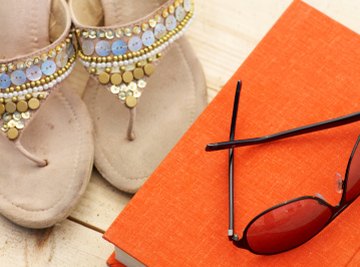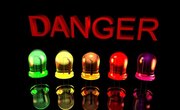
Controlling the brightness of LEDs (light emitting diodes) lets you get more out of your LED design. If you're a fashion designer, you can create more subtle effects in your LED studded clothes when you make colored LEDs brighter. For around the house, making your LEDs shine brighter will make it easier to read books and newspapers. It is not difficult to make an LED brighter, however trying to make your LED shine too bright or shine too bright for too long, could result in a shorter LED life or a LED that doesn't light at all.
Preliminary Calculations
- Resistors
- Battery
- Calculator
You can use a variable resistor instead of fixed resistors. This will let you control the brightness with a knob. You can also construct a circuit that will vary the voltage of the applied voltage. In these circuits, you will have to limit the range of the applied voltage so that you don't exceed the maximum forward current specifications for the LED.
Improper use of electronic equipment and components can result in fire, serious injury, or death. Always work under the supervision of a safety certified electronic technician or electronic engineer. Obtain an electronic safety certificate before you work with electronic equipment and components.
Construct a table with two columns and four rows. Label one left column, "Current (mA)" for current in milliamperes. Label the right column "Brightness (mcd)" for luminous intensity in millicandelas.
Examine the current/brightness curve given in the manufacturer's LED specification sheet. Mark four points on the curve with your pencil and label them "1" through "4." Write the current level for the first point on the curve in the row one, column one of the table. Write the brightness level for the first point on the curve in row one, column 2 of the table. Continue in this fashion for the remaining three points you marked on the curve.
Subtract from the battery voltage (you are going to use to power your LED) the LED "forward voltage" from the manufacturer's specification sheet. Label this result as "voltage drop across the brightness resistor or Vbr." Divide Vbr by the highest current value in the table to determine the value of resistor you will need to make the LED the brightest. Label this result as "Resistor for highest brightness or Rb."
Divide "Vbr" by the lowest current value in the table to obtain the resistor value for the lowest brightness level. Label the result as "Rlb" for "resistor value with lowest brightness level."
Connect the positive terminal of the battery to the left lead of resistor Rbl. Connect the right lead of resistor Rbl to the positive terminal of the LED (anode). Connect the negative terminal of the LED (cathode) to the negative terminal of the battery. Observe the brightness level of the LED.
Replace resistor Rbl, the low brightness resistor, with Rb, the high brightness resistor. Observe that the brightness level is greater with Rb then with Rbl
Things You'll Need
Tips
Warnings
About the Author
Mark Stansberry has been a technical and business writer over for 15 years. He has been published in leading technical and business publications such as "Red Herring," "EDN" and "BCC Research." His present writing focus is on computer applications programming, graphic design automation, 3D linear perspective and fractal technology. Stansberry has a Bachelor of Science in electrical engineering from San Jose State University.
Photo Credits
Ryan McVay/Photodisc/Getty Images
